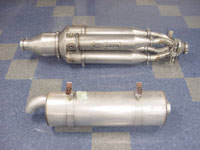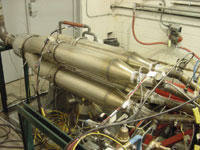 Much of AEI’s business revolves around proprietary exhaust aftertreatment system development. AEI’s personnel, testing facilities, and emissions analyzers are ideally suited for the development of new aftertreatment technology. Projects include work to understand catalyst chemistry,
Much of AEI’s business revolves around proprietary exhaust aftertreatment system development. AEI’s personnel, testing facilities, and emissions analyzers are ideally suited for the development of new aftertreatment technology. Projects include work to understand catalyst chemistry,  flow distribution, space velocities, and optimize dosing system. The majority of this work is confidential. Non-confidential projects are described below.
flow distribution, space velocities, and optimize dosing system. The majority of this work is confidential. Non-confidential projects are described below.
Exhaust Emission Control System for Heavy-Duty On-Highway Diesel Engines
AEI, worked in conjunction with the US Environmental Protection Agency, designed, manufactured and tested a four leg aftertreatment system for heavy duty diesel engines. The challenges of the program included minimizing any impact to the vehicle and its systems; size, durability, exhaust restriction, and fuel economy implications being the major concerns. As shown in this picture, the system had to fit within the packaging constraints of the current vehicle’s muffler.
Several four-flow path valve designs were conceived and prototyped, but precise and rapid control in high exhaust temperatures was also somewhat of a challenge. Eventually, the design chosen for the development was a simple and low cost design with robust valving and actuators to control exhaust flow to each leg. AEI demonstrated a composite 98% NOx reduction with only a 3.4% fuel consumption increase.
A patent was issued for the design. AEI has full licensing rights to this patent, with inventors from both AEI and the EPA.
Another major mechanical challenge was to find or design an inexpensive, robust fuel injector to introduce the reductant agent during NOx or sulfur regeneration at low pressures with good fuel spray atomization. No injectors that met the above criteria were commercially available, so one was developed at AEI that uses the pressure-swirl atomization technique to deliver a fine atomization of fuel at a very low injection pressures – under 50 psi.
One of the systems was ultimately installed on the Mobile Emissions Laboratory built for the EPA.